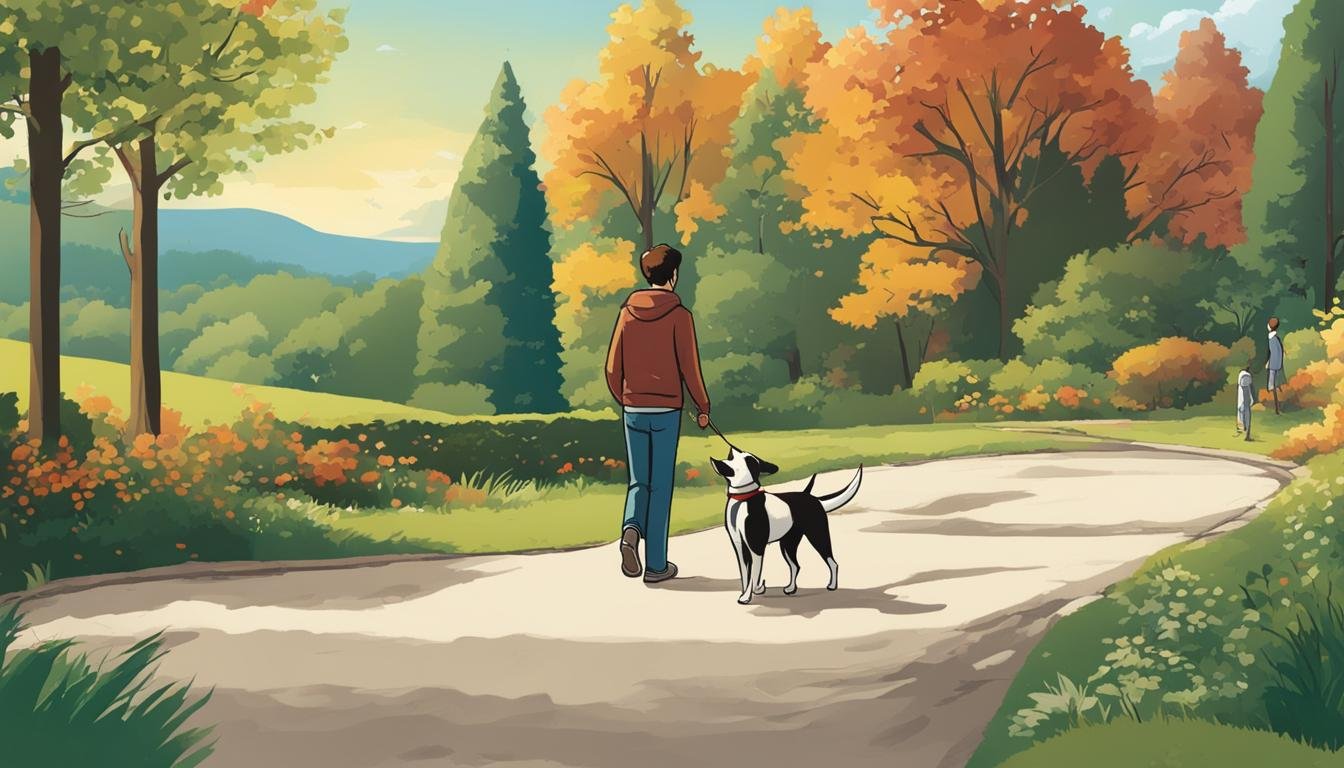Have you ever wondered why your dog always seems to be walking behind you during your walks together? This behavior is actually quite common and can be attributed to various factors related to your dog’s behavior, training, and environmental influences.
Understanding why your dog exhibits this behavior is important for building a strong and harmonious relationship with your furry friend. In this article, we will explore the reasons behind this behavior and provide insights on how to address it effectively.
Key Takeaways:
- Walking behind their owner is a natural behavior for dogs, associated with their pack mentality and desire to submit to the alpha.
- Dogs may walk behind due to excessive sniffing, exploring scents, or becoming familiar with their surroundings.
- Fear and anxiety can also cause dogs to walk behind their owners, highlighting the importance of positive reinforcement and creating a safe environment.
- Proper training and obedience can influence walking behavior, emphasizing the need for consistency and patience during training sessions.
- Unfamiliar environments, physical discomfort, and fatigue can contribute to dogs walking behind their owners, requiring gradual exposure and proper gear.
By understanding the underlying reasons behind your dog’s behavior and implementing appropriate training techniques, you can help your furry companion become a confident and well-behaved walker, strengthening the bond between you and your four-legged friend.
The Role of Scent in Dogs’ Walking Behavior
When it comes to understanding why your dog walks behind you, one important factor to consider is the role of scent in dogs’ walking behavior. Dogs have an incredible sense of smell, with more than 100,000 scent receptors in their noses.
This heightened sense of smell allows dogs to gather information about their environment as they walk. When your dog walks behind you, they may be sniffing the ground and various scents along the way. It’s their way of exploring and learning about the world around them.
While it may be tempting to discourage excessive sniffing, it’s important to understand that this behavior is natural for dogs. Allowing your dog some time to use their nose during walks can provide mental stimulation and enrichment. It’s part of their instinctual behavior and helps them gather important information from their surroundings.
The Role of Fear and Anxiety in Dogs’ Walking Behavior
Understanding the underlying reasons for why your dog walks behind you is crucial in addressing and managing their behavior. In some cases, fear and anxiety can play a significant role in causing dogs to exhibit this behavior.
Fearful dogs may walk behind their owners as a way to seek reassurance and protection. Previous negative experiences, such as traumatic events or harsh training methods, can contribute to their anxiety and reluctance to walk ahead. It is essential to create a safe and secure environment for these dogs, using positive reinforcement and gentle training techniques to build their confidence. Consulting with a professional dog trainer or behaviorist can provide valuable guidance in helping your fearful dog overcome their anxiety and regain trust.
Anxious dogs may also exhibit walking behind behaviors due to their overall nervous disposition. Everyday situations, such as encountering unfamiliar dogs or loud noises, can trigger anxiety and cause them to seek comfort by staying close to their owners. Implementing desensitization and counter-conditioning exercises, along with providing a calm and predictable routine, can help alleviate their anxiety and improve their walking behavior.
Training and Obedience as Factors in Walking Behavior
When it comes to your dog’s walking behavior, training and obedience play a crucial role. By implementing effective training techniques and establishing clear expectations, you can encourage your furry friend to walk by your side rather than behind you.
Leash training is an essential aspect of teaching your dog to walk with you. Start by using a properly fitted leash and collar or harness, ensuring your dog feels comfortable and unrestricted. Use positive reinforcement techniques, such as treats and praise, to reward your dog for walking beside you. Consistency is key, so reinforce the desired behavior each time you go for a walk.
Obedience training is also important in shaping your dog’s walking behavior. Teach your dog commands like “heel” and “walk” to indicate that they should walk calmly by your side. Use consistent cues and rewards to reinforce these commands, helping your dog understand what you expect from them during walks. This creates a strong bond between you and your dog and fosters a sense of trust and cooperation.
Creating a Positive Walking Experience
During training sessions, it’s important to create a positive and enjoyable walking experience for your dog. Keep walks interesting by varying the routes and environments to provide mental stimulation. This helps prevent boredom and encourages your dog to stay engaged and focused on walking with you.
Remember to be patient and understanding during the training process. Dogs learn at their own pace, and some may require more time to grasp the concept of walking beside you. By using positive reinforcement and providing a safe and supportive environment, you can help your dog develop good walking habits and enhance your overall walking experience together.
Environmental Factors Affecting Walking Behavior
When it comes to why your dog walks behind you, environmental factors can play a significant role. New environments and unfamiliar territory can cause your dog to feel cautious or curious, leading them to lag behind during walks. Dogs are naturally inclined to explore and gather information about their surroundings, and in new places, they may need some time to adjust.
Proper socialization as a puppy can help prevent fear or discomfort in new environments. Gradually exposing your dog to different places and experiences can help them become more confident and comfortable, reducing the tendency to walk behind you. Encourage positive associations with new environments by rewarding your dog with treats, praise, and affection when they demonstrate calm behavior and walk by your side.
Importance of Dog Socialization
Dog socialization is crucial in helping your furry companion navigate new environments and unfamiliar territory. By exposing your dog to various people, dogs, and situations, you can help them develop the skills and confidence needed to handle different walking scenarios. Socialization can also reduce the chances of fear or anxiety-related behaviors, including walking behind you.
Ensure that socialization experiences are positive and supervised to prevent any negative encounters that may affect your dog’s walking behavior. Gradually increase the level of difficulty and exposure, allowing your dog to become gradually more comfortable and confident in different environments.

By understanding and addressing the environmental factors that affect your dog’s walking behavior, you can create a more enjoyable and harmonious walking experience for both you and your furry friend. Remember to be patient and supportive as your dog adapts to new surroundings, providing them with the guidance and reassurance they need to walk confidently by your side.
Physical Discomfort and Fatigue as Causes for Walking Behind
Physical discomfort and fatigue can contribute to a dog’s behavior of walking behind their owner. Uncomfortable gear, such as a tight collar or ill-fitting harness, can cause discomfort, leading the dog to lag behind. It is important to ensure that your dog’s gear fits properly and does not cause any discomfort or pain. Regularly check their collar or harness for any signs of wear or tightness.
Fatigue can also be a factor in a dog’s tendency to walk behind their owner. If your dog is tired from exercise or a lengthy walk, they may need to rest and walk at a slower pace. Pay attention to your dog’s energy levels and provide breaks during walks to allow them to recover. Remember, walks should be enjoyable for both you and your dog, so don’t push them too hard or expect them to keep up a fast pace if they are tired.
Uncomfortable gear
can lead to a dog walking behind their owner, as the discomfort makes them hesitant to walk beside you. It is essential to regularly inspect your dog’s gear and ensure that it fits comfortably and securely. If you notice any signs of discomfort or irritation, consider replacing it with a better-fitting option.
Tired dog
may also prefer to walk behind their owner to conserve energy. Dogs, like humans, can get tired during physical activities, so it is crucial to recognize when your dog needs a break. Allow them to rest and recover before continuing the walk, ensuring they are comfortable and not overexerted.
Conclusion
Understanding your dog’s walking behavior is crucial for building a strong bond and fostering a positive owner-dog relationship. Dogs naturally have a pack mentality and may walk behind you as a sign of submission and respect. However, it is important to ensure that this behavior is not reinforced inadvertently through rewards or negative reinforcement.
Training plays a significant role in shaping your dog’s walking behavior. Positive reinforcement, such as treats and praise, is more effective than negative reinforcement. Teaching commands like “heel” and “walk” can help establish expectations and encourage your dog to walk by your side.
Additionally, factors such as fear, anxiety, physical discomfort, and unfamiliar environments can also contribute to your dog walking behind you. To address these issues, create a safe and secure environment for your dog, using positive reinforcement to build their confidence and alleviate fear and anxiety.
By understanding the reasons behind your dog’s walking behavior and addressing them through proper training, positive reinforcement, and socialization, you can improve their walking patterns and strengthen the bond between you and your furry companion.
FAQ
Why does my dog walk behind me?
One of the most common reasons your dog walks behind you is that they recognize you as the alpha and submit to you. Dogs have a pack mentality, and they see their owners as the pack leader.
What role does scent play in dogs’ walking behavior?
Dogs have an incredible sense of smell, with more than 100,000 scent receptors. When your dog walks behind you, they may be sniffing the ground and various scents along the way. This allows them to gather information about their surroundings.
Can fear and anxiety cause dogs to walk behind their owners?
Yes, some dogs may walk behind their owners out of fear or anxiety. This could be due to previous negative experiences or a lack of confidence. Positive reinforcement and creating a safe environment can help address this behavior.
How does training and obedience influence dogs’ walking behavior?
The way you train and interact with your dog can influence their walking behavior. Positive reinforcement, using treats and praise, is generally more effective than negative reinforcement. Teaching commands such as “heel” and “walk” can help your dog understand your expectations during walks.
Do environmental factors affect dogs’ walking behavior?
Yes, dogs may walk behind their owners in new or unfamiliar environments. Proper socialization as a puppy can help prevent fear or discomfort in new places. Gradually exposing your dog to new experiences can help them become more confident and comfortable.
Can physical discomfort or fatigue cause dogs to walk behind?
Yes, uncomfortable gear or fatigue can contribute to a dog walking behind their owner. Ensuring your dog’s gear fits properly and providing breaks for rest can help address this behavior.

